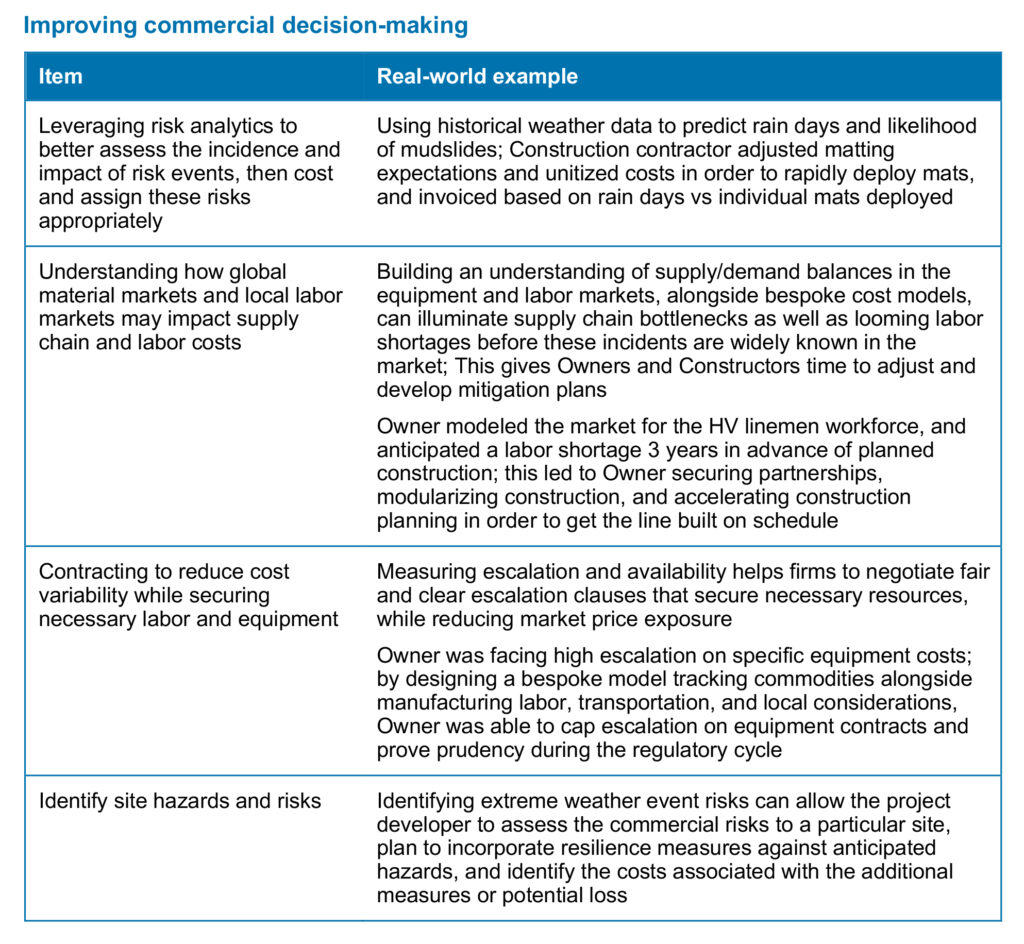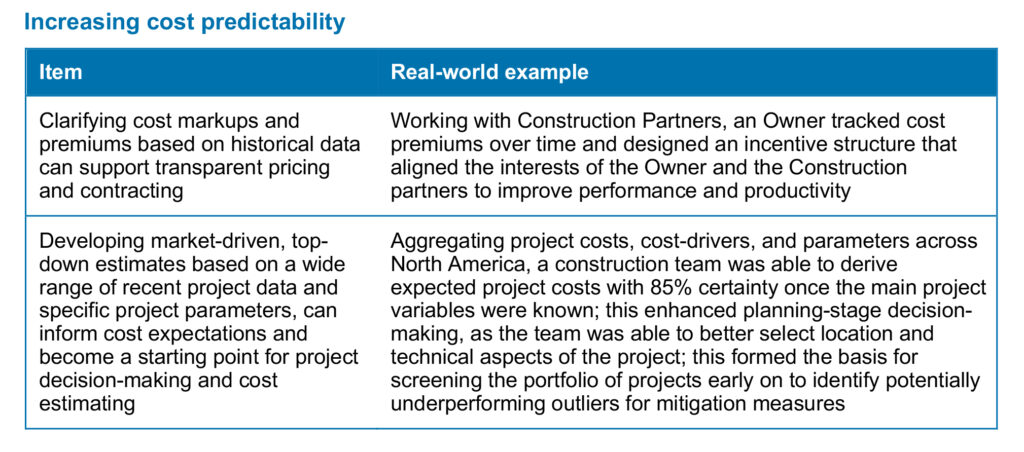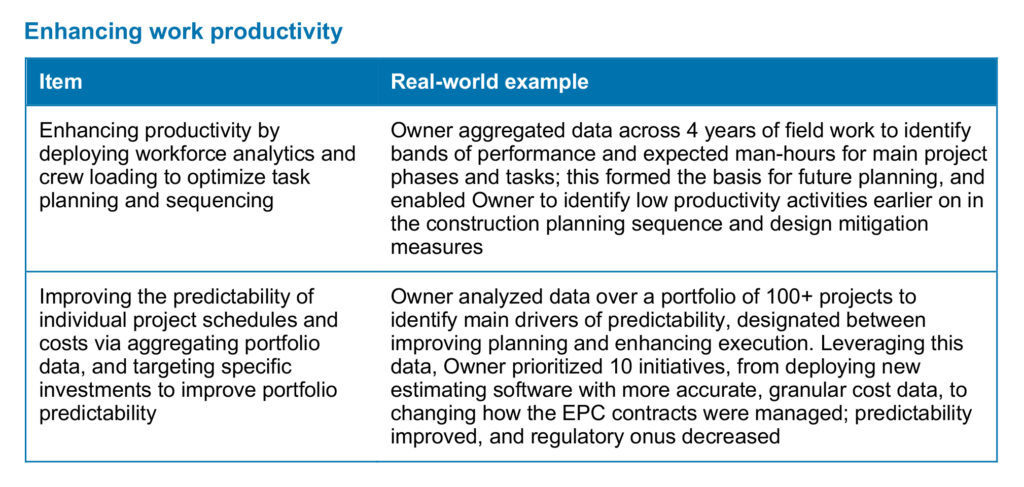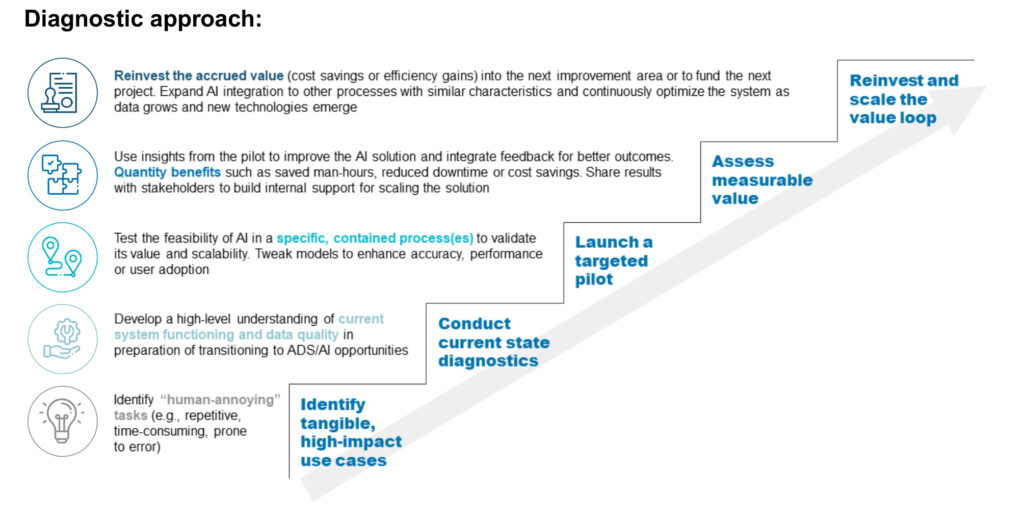As businesses wait for artificial intelligence to mature, there is an opportunity to start implementing the data and functionality that is readily available now. Planning and delivering a complex, multi-billion dollar capital project creates a trove of actionable data and insights, if teams are able to manipulate the data to reveal these insights.
The detail involved in planning, financing, engineering, constructing, and running a large infrastructure asset requires a vast array of information and precise actions to be successful. Traditional PMOs often track and regurgitate lessons learned from mistakes where projects went awry. This is a helpful starting point from which to contemplate future improvements, however, project teams that are truly insightful and forward-looking will proactively scrape data from all facets of the program and leverage analytics to turn these trillions of data points into actionable insights. In doing so, this data can be employed to create lasting value and continuous improvement for the program.
For decades, project organizations could get by without leveraging advanced insights to improve program performance. Data was not readily available and required intense analytics to clean and deploy. However, with the accelerating infrastructure buildout in energy and related industries, capital programs face mounting pressure to maximize the impact of their investments and achieve more with fewer resources. In this increasingly competitive landscape, success hinges on the ability to proactively leverage data to drive down costs without compromising quality, accelerate schedules by optimizing delivery methods, mitigate risks, streamline financing, and meet a host of other critical demands.
The most fruitful project management teams apply a programmatic approach to capturing, analyzing, and deploying data across all their activities. Fortunately for these programs, data science as an industry has now matured to be able to systematically assess and drive insights, making data cleansing and deployment much more efficient and accessible.
Successful Teams Focus on Impact
What differentiates programs that successfully deploy data-driven insights from those that flounder is the accumulated human experience of project teams, construction managers, and the other team members who direct the analysis. They understand which functions, variables, and data are dependent and inter-related, and have the accumulated experience to know which insights will be the most valuable for their project teams. Successful organizations leverage their experience to know which questions to ask, to make connections between different project parameters, activities, and costs, and to objectively route analytics to derive opportunities and improvements from what they have discerned. The most effective organizations focus on activities and analyses that add the most value, to efficiently drive insights while utilizing less resources.
Data Drives Value Within the Program Lifecycle
All project organizations, no matter what size or scope, have the ability to successfully utilize data to inform decision-making and performance. What is critical is the ability to know where to look, what to look at, how to evaluate it, and how to then act on these findings. Some of the most relevant insights our team has encountered over the last two decades of working with large capital programs are as follows:



Data Should Always Enhance Program Value
Teams that successfully deploy data insights across their portfolio can do so because the insights they are creating accrue obvious, measurable, and scalable value to individual projects. When developing a data-driven outlook, teams should focus on using data to:
• Identify and adapt to trends: understanding how economic, market, climate and other trends will impact a project can enable teams to devise mitigations and proactively take action to address burgeoning challenges
• Identify and learn from outliers: identify outliers by creating portfolio-specific expectations of how projects will perform, and focus team efforts on specific mitigations to better allocate resources where they are needed
• Understand cost and schedule implications of decisions: enhancing how teams use data to make pricing, contracting, schedule, and risk decisions can illuminate the impacts of these choices, and help clarify trade-offs and implications of decisions over the course of the project
• Track portfolio performance for continuous improvement: building out a data-enhanced perspective of portfolio performance aids teams in objectively identifying trends, lessons learned, and tranche improvement initiatives for the portfolio moving forward
The value derived from successful analysis and the deployment of data to programs is multi-faceted: from improving planning, making better-informed cost decisions, and enhancing productivity in the field.
Deriving Analytics and Creating a Programmatic Approach
Standing up data insights and deploying actionable intelligence to a project organization does not happen overnight. Typically, teams start with the available data at hand, find insights, and create a virtuous loop that enables them to drive value, prove the concept, and then grow the analytics footprint across the broader project organization.
Assessing where to begin, given the array of available data, can be overwhelming. Teams often question who should hold the responsibility for the analysis, and how to best react and collaborate moving forward with these analytics.
Initially, performing a quick diagnostic is recommended, both to understand what data is readily available, and to pinpoint areas most in need of focus. Results range for each organization, but typically within a capital program we find that cost/contracting premiums, cost predictability, and portfolio trends and outliers are common preliminary areas for organizations to begin. These areas usually have readily available data from recent projects and an efficient analysis can be performed to drive insights.

Creating a programmatic approach to capturing, analyzing, and deploying data into project organizations helps launch a learning cycle that will generate measurable value and improve program resiliency over time. It is paramount for project organizations to take the initiative and establish these procedures early on to be successful in this evolving and competitive industry.
—Christine Oumansour is a vice president in CRA’s Energy Practice, based in Boston, Massachusetts. She works with energy companies at the intersection of energy transition strategy and capital portfolio execution.

















